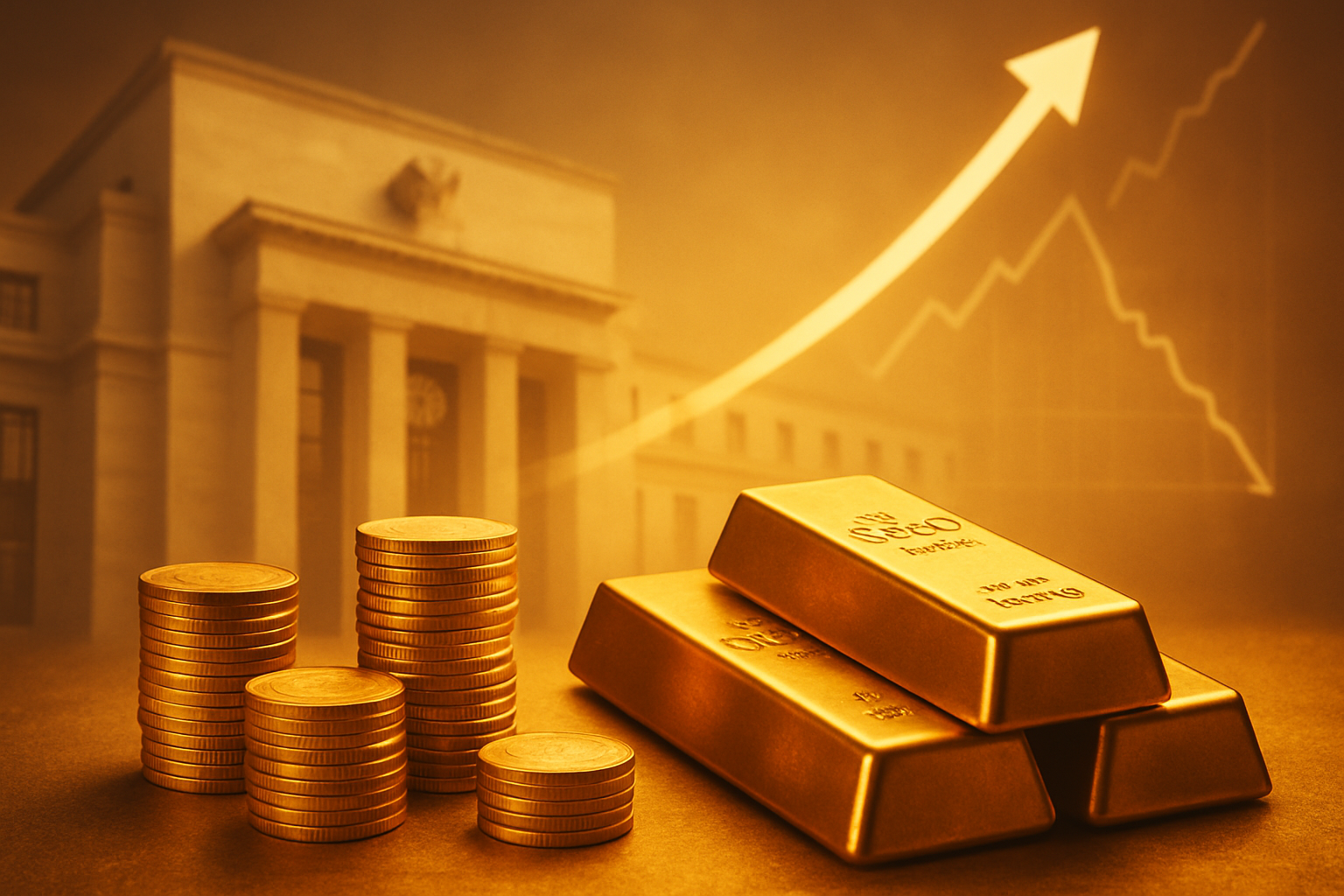
New York, NY – October 7, 2025 – Gold prices have surged to unprecedented levels, with spot gold reaching $3,962 per ounce and December futures nearing $3,985, having briefly surpassed the $4,000 mark. This remarkable rally, which has seen the precious metal climb over 50% year-to-date, is primarily driven by a pervasive perception of a dovish Federal Reserve and strong market expectations for aggressive future interest rate cuts. The immediate implication is a significant re-evaluation of investment portfolios as institutions and individuals flock to gold as a primary safe-haven asset amidst growing economic uncertainties and a weakening U.S. dollar.
The gold market is currently experiencing a "perfect storm" of bullish factors, making it the top-performing major asset of 2025. This ascent is indicative of a deep-seated "fear premium" and "Fear Of Missing Out" (FOMO) among investors, prompting a substantial reallocation of capital. Gold's historical negative correlation with equities during periods of market stress further enhances its appeal as a diversification tool. While analysts are revising gold price forecasts upwards, with some predicting targets near $4,900 by 2026, driven by continued central bank buying and looser monetary policy, technical indicators suggest the metal is "extremely overbought," hinting at the potential for a significant correction.
The Federal Reserve's Pivotal Role in Gold's Ascent
The primary catalyst behind gold's recent stratospheric rise is the Federal Reserve's increasingly dovish monetary policy stance and widespread market anticipation of further interest rate reductions. The Fed initiated a 25-basis-point rate cut in September 2025, marking the first reduction since December 2024. Now, markets are overwhelmingly pricing in another quarter-percentage-point cut at the upcoming Federal Open Market Committee (FOMC) meeting on October 28-29, 2025, which would lower the fed funds rate to a range of 3.75% to 4%. Traders are betting heavily on easing monetary policy before year-end, with over 94% probability priced in for an October cut and further reductions expected well into 2026.
This shift in monetary policy significantly alters the opportunity cost of holding gold. As a non-yielding asset, gold becomes more attractive when interest-bearing alternatives, such as bonds or savings accounts, offer diminished returns in a low-interest-rate environment. Concurrently, lower interest rates typically lead to a weaker U.S. dollar, as foreign investors find U.S. dollar-denominated assets less appealing. A depreciating dollar, in turn, makes gold, which is globally priced in the U.S. currency, cheaper for international buyers, thereby stimulating demand and pushing prices higher.
Fed officials are reportedly cutting rates due to concerns about a softening labor market and a strategic desire to lower borrowing costs to spur hiring. Recent softer employment data and moderating inflation figures have provided the central bank with the necessary leeway to ease its policy. Prominent policymakers, including Governor Stephen Miran, have openly voiced support for additional rate cuts, reflecting a broad dovish consensus within the Fed. Adding another layer of complexity, the ongoing U.S. government shutdown has delayed the release of crucial economic indicators, forcing investors to rely on secondary data to gauge the extent and timing of future Fed actions. This uncertainty further contributes to gold's allure as a reliable store of value.
Beyond the dovish Fed, robust safe-haven demand stemming from the ongoing U.S. government shutdown, escalating global political instability in regions like France and Japan, and persistent geopolitical tensions are also fueling the gold rally. Furthermore, central banks, particularly those in China and other emerging markets, have been aggressively accumulating gold to diversify their reserves away from dollar-denominated assets, seeking insurance against currency risk and broader financial instability. Lingering concerns about inflation also bolster gold's traditional role as a hedge against the erosion of purchasing power.
Winners and Losers in a Gold-Fueled, Dovish Fed Landscape
The current environment of surging gold prices, driven by a dovish Federal Reserve and anticipated interest rate cuts, creates a distinct landscape of winners and losers across various sectors of the public market. The "easy money" policies fostered by lower interest rates are designed to stimulate borrowing, spending, and investment, which generally supports economic growth and equity markets. However, the unique dynamics of gold's rally amplify the fortunes of certain industries and challenge others.
Gold Mining Companies: The Obvious Beneficiaries
Unsurprisingly, gold mining companies are the most direct and significant beneficiaries of a gold price rally. Higher gold prices directly translate into expanded profit margins, robust cash flows, and strengthened balance sheets. This improved profitability allows these companies to potentially increase dividends, initiate share buybacks, and invest more aggressively in exploration and the development of new projects, making previously uneconomical deposits viable. Companies with relatively low All-in Sustaining Costs (AISC) are poised to capture the most substantial gains. Royalty and streaming companies, which provide upfront capital to miners in exchange for a percentage of future production or revenue, also benefit immensely, offering leveraged exposure to gold prices with reduced operational risks.
Leading examples of gold mining companies experiencing a boon include Newmont Corporation (NYSE: NEM), Barrick Gold Corporation (NYSE: GOLD), Agnico Eagle Mines Limited (NYSE: AEM), Kinross Gold (NYSE: KGC), and Gold Fields (NYSE: GFI). Royalty and streaming giants like Wheaton Precious Metals Corp. (NYSE: WPM) and Franco-Nevada Corporation (NYSE: FNV) are also seeing significant upside. While gold bullion has reached record highs, it's worth noting that some gold mining stocks have historically lagged the metal's surge, yet many have still posted significant gains in 2025, demonstrating the complex interplay between commodity prices and mining operational realities.
Sectors Buoyed by Interest Rate Cuts
Beyond the direct gold plays, a dovish Fed leading to interest rate cuts generally stimulates broader economic activity by making borrowing cheaper for both businesses and consumers. This environment particularly favors:
- Real Estate and Homebuilding: Lower interest rates translate to more affordable mortgages, directly boosting housing demand and new construction. Companies such as D.R. Horton (NYSE: DHI), Lennar (NYSE: LEN), and PulteGroup Inc. (NYSE: PHM), along with building material suppliers, are likely to see increased sales and profitability. Real Estate Investment Trusts (REITs) may also become more attractive as their dividend yields compare favorably to lower fixed-income alternatives.
- Technology and High-Growth Companies: These firms often rely on external funding for research and development and expansion initiatives. Cheaper capital reduces their borrowing costs, fueling innovation and accelerating growth. Lower discount rates also tend to inflate the valuations of growth stocks with strong future earnings potential, benefiting tech giants and emerging innovators.
- Consumer Discretionary: With lower borrowing costs, consumers often have more disposable income, which can translate into increased spending on non-essential goods and services, benefiting sectors like retail, autos, and travel.
- Small-Cap Stocks: Historically, small-cap companies are highly sensitive to rate cuts, which can boost liquidity and reduce their cost of capital, enhancing their growth prospects.
Potential Underperformers and Challenges
While many sectors stand to gain, a dovish Fed and soaring gold prices present challenges for others:
- Certain Financial Institutions: While the broader banking sector can benefit from increased lending activity, financial institutions with high-cost deposits or those operating in highly competitive markets may face pressure on their net interest margins in a sustained low-interest-rate environment. Insurance companies with long-duration liabilities could also see their liabilities increase in present value, impacting profitability.
- Industries Reliant on Gold as a Raw Material: Sectors that use gold as a primary raw material, such as the jewelry industry, may face significant margin pressures due to the higher cost of their inputs. These companies might need to adapt by using lighter designs or exploring alternative materials.
- Companies Highly Leveraged to a Stronger Dollar: A dovish Fed and interest rate cuts typically lead to a weaker U.S. dollar. Companies that primarily export goods or have substantial overseas earnings might see these earnings translate into fewer dollars when repatriated, potentially negatively impacting their reported revenue and profitability.
It's crucial to remember that market performance is influenced by a multitude of factors beyond just interest rates and gold prices, including broader economic conditions, geopolitical events, company-specific fundamentals, and overall market sentiment. The actual impact on individual companies can therefore vary significantly.
Wider Significance: A Shifting Global Financial Landscape
The unprecedented rally in gold prices, propelled by a dovish Federal Reserve and expectations of sustained interest rate cuts, is not merely a market anomaly but a profound indicator of shifting global economic and geopolitical dynamics. This surge reflects a complex interplay of monetary policy, escalating geopolitical instability, and evolving investor sentiment, carrying significant wider implications across various industries and financial markets. With gold prices approaching or surpassing the $4,000 per ounce mark, the repercussions are far-reaching.
Broader Industry Trends and Ripple Effects:
Gold's robust performance often serves as a bellwether for the broader commodity market. In tandem with gold, silver has mirrored its rally, experiencing substantial gains. Industrial metals, such as copper, have also shown strong performance, contributing to a positive trend in broader commodity indices as investors seek tangible assets to hedge against inflation. While gold rallies amidst economic uncertainty, equities have, perhaps paradoxically, continued to scale fresh peaks, indicating a nuanced market where different asset classes are responding to distinct drivers. However, lower bond yields, a direct consequence of a dovish Fed, inherently make non-interest-bearing assets like gold more appealing. Conversely, any erosion of confidence in fiscal and monetary policy, evidenced by long-term bond yields rising despite dovish signals, could steepen the yield curve and further bolster demand for non-fiat assets like gold as a hedge against currency debasement.
The weakening U.S. dollar is a pivotal factor in gold's strength. The euro has also shown weakness, influenced by the U.S. government shutdown and political turmoil in France, underscoring the current climate of currency volatility. The aggressive trend of central banks diversifying their reserves away from the U.S. dollar, particularly by accumulating gold, signals a broader, strategic shift in global reserve asset allocation.
The mining industry, especially gold producers, is experiencing a boom. Major producers are witnessing substantial margin expansion as the soaring gold price outpaces their production costs. This increased profitability translates into strengthened balance sheets, record cash flows, and enhanced shareholder returns through dividends and buybacks. The industry is prioritizing disciplined capital allocation and internal project development, although increased merger and acquisition activity and exploration efforts are also observed. Conversely, the jewelry industry faces challenges. Higher gold prices lead to increased retail prices for gold jewelry, potentially prompting shifts in consumer behavior towards lower-carat items, alternative metals, or a greater interest in gold as an investment rather than purely decorative item. Some consumers might even liquidate existing gold heirlooms to capitalize on the high prices.
Regulatory and Policy Implications:
The sustained gold rally could exert increased pressure on governments and central banks to manage inflation, particularly if the rally is perceived as a signal of broader price level increases. This presents a delicate balancing act for monetary policy decisions, potentially leading to a more hawkish stance from central banks despite prevailing calls for rate cuts. Furthermore, market authorities may consider enhanced regulation of gold markets and investment vehicles to manage potential speculation and ensure stability, including increased reporting requirements for large gold transactions to monitor capital flows. The aggressive gold purchasing by central banks highlights a strategic shift in reserve asset allocation, driven by de-dollarization initiatives. This trend signifies a proactive approach by nations to build gold reserves while others might contemplate strategic sales. The appreciation of gold could also accelerate the development of Central Bank Digital Currencies (CBDCs) as potential alternatives to traditional monetary systems.
Historical Precedents and Comparisons:
The current gold rally shares striking similarities with past periods of economic uncertainty and monetary easing. Gold has historically thrived when interest rates are low, as the opportunity cost of holding the non-yielding asset diminishes. Analysis of previous monetary easing cycles consistently demonstrates that gold typically outperforms during these periods, with the current rally exhibiting even stronger momentum. Historically, gold prices spike during times of inflation, market instability, and global uncertainty, acting as a reliable safe haven. The correlation between uncertainty indices and gold price movements in early October 2025 is at its strongest level since 2020. While unique in its specifics, the current rally echoes the 1979-1980 gold boom and market responses to the 2008 Global Financial Crisis and the COVID-19 pandemic. The bull phase from 2001-2025 is seen as paralleling the 1970-1980 pattern, characterized by prolonged monetary easing, deficits, and rising commodity correlations. The 51% surge in gold's annual performance in 2025 marks its strongest since 1979, when gold soared 125% amid double-digit inflation. The rally's inception can be traced back to 2022, notably triggered by the freezing of Russian foreign holdings.
What Comes Next: Navigating Gold's Bullish Horizon
The current financial landscape, dominated by a dovish Federal Reserve and ongoing interest rate cuts, paints an overwhelmingly bullish picture for gold prices in both the short and long term. With gold having surged past $4,000 per ounce and registering its strongest annual performance since 1979, the market is now grappling with the implications of this new paradigm and what it portends for the future.
Short-Term Trajectory and Market Watch:
In the immediate future, market attention will remain fixated on upcoming Fed announcements. A confirmed rate cut in October 2025, coupled with continued dovish signals, is highly likely to provide additional impetus for gold to breach and consolidate above the $4,000 mark. Technical analysis suggests the next psychological milestone is $4,100, with robust technical support established at $3,783. Some forecasts project gold reaching $4,100-$4,300 per ounce in the near term. While the Relative Strength Index (RSI) indicates overbought conditions, suggesting the potential for a temporary correction, the underlying momentum remains exceptionally strong, with buyers aggressively defending any dips. Geopolitical developments, including the ongoing Russia-Ukraine conflict, political instability in other regions, and the U.S. government shutdown, will continue to fuel safe-haven demand, providing a persistent tailwind for gold.
Long-Term Structural Shifts and Elevated Targets:
The long-term outlook for gold appears anchored by significant structural shifts that extend beyond mere monetary policy. Major financial institutions like Goldman Sachs have substantially lifted their December 2026 gold forecast from $4,300 to $4,900, citing resilient central bank accumulation, persistent geopolitical stress, and falling U.S. real yields. Analysts are increasingly discussing targets of $4,500 or even $5,000 per ounce within the next 12-18 months, particularly if inflation proves more stubborn than anticipated or if geopolitical tensions escalate further.
Key long-term drivers include:
- Unprecedented Central Bank Purchasing: Central banks globally, especially in emerging markets, are aggressively accumulating gold to diversify their reserves away from U.S. Treasuries, driven by de-dollarization initiatives and concerns over sanctions risk.
- Persistent Geopolitical Instability: Overlapping global conflicts and political uncertainties, with no clear resolution in sight, are creating a persistent risk premium in gold markets, supporting higher baseline prices.
- Currency Debasement Concerns: Rising long-term bond yields, despite dovish signals, suggest waning confidence in fiscal and monetary policy, driving investors toward tangible stores of value like gold amidst fears of currency debasement.
- Structural Demand Changes: A sustained re-evaluation of gold's role in diversified portfolios is leading to strategic, rather than tactical, allocation to gold, providing sustained support from institutional capital flows.
Strategic Pivots and Emerging Opportunities/Challenges:
Given this environment, investors might consider several strategic pivots. Increased allocation to physical gold and gold-backed Exchange-Traded Funds (ETFs) becomes more appealing due to reduced opportunity costs and strong fundamentals. Investing in gold mining companies with robust balance sheets and low production costs, such as Barrick Gold Corporation (NYSE: GOLD) and Newmont Corporation (NYSE: NEM), offers direct exposure to surging gold prices. Diversification into the broader precious metals complex, including silver and platinum group metals, could also be considered, as these often rally in tandem with gold during periods of market concern.
However, challenges persist. Despite the strong rally, gold prices can exhibit short-term volatility, and overbought signals suggest the potential for temporary corrections. A stronger-than-expected rebound in the U.S. dollar, or an unexpected hawkish pivot from the Fed, could create headwinds for gold. Furthermore, governments and central banks might face pressure to manage inflation, potentially leading to regulatory interventions or a shift to a more hawkish stance. The higher gold climbs, the greater the potential for speculative bubbles and subsequent corrections, necessitating thorough due diligence and effective risk management from investors.
Potential Scenarios:
Several scenarios could unfold:
- Continued Steady Ascent (Most Likely): If geopolitical tensions persist, central banks continue their buying spree, and the Fed maintains its dovish stance with further rate cuts, gold could see a continued, steady ascent, potentially towards $5,000 per ounce or even higher. This assumes persistent, albeit stubborn, inflation and slowing economic activity compelling the Fed to ease policy further.
- Volatile "Boom and Bust" Cycle: If economic stability temporarily returns or if a major, unexpected shift in monetary policy occurs (e.g., a sudden hawkish turn by the Fed), gold could experience more volatile "boom and bust" cycles.
- "Soft Landing" Scenario: If the Fed's easing successfully engineers a "soft landing"—sustained growth with moderating inflation—the short-term positive momentum for commodities might temper in the long run as confidence in traditional markets recovers. However, the risk of persistent inflation despite rate cuts could still keep gold attractive.
In essence, with a dovish Fed, anticipated rate cuts, and prevailing global uncertainties, the outlook for gold is overwhelmingly bullish. While short-term volatility and potential corrections are possible, structural drivers like central bank demand and geopolitical risks are expected to provide strong underlying support for gold's elevated price levels. Investors are strategically pivoting towards gold and related assets as a crucial component for portfolio diversification and wealth preservation in a changing economic landscape.
Comprehensive Wrap-Up: Gold's Enduring Allure in a New Era
The historic rally in gold prices, pushing the precious metal beyond the $4,000 per ounce threshold, marks a pivotal moment in financial markets. This surge, primarily ignited by a dovish Federal Reserve and the strong expectation of further interest rate cuts, underscores a significant shift in investor sentiment and macroeconomic dynamics. Gold's extraordinary 50% year-to-date gain by October 7, 2025, reflects its enduring appeal as a safe-haven asset and an inflation hedge in a world grappling with persistent uncertainties.
Key Takeaways:
The core drivers of this rally are multifaceted: a Federal Reserve committed to accommodative monetary policy, leading to lower interest rates and a weaker U.S. dollar; robust safe-haven demand fueled by geopolitical instability and economic uncertainty; and aggressive gold accumulation by central banks globally. These factors collectively reduce the opportunity cost of holding non-yielding gold and enhance its attractiveness as a reliable store of value.
Assessment of the Market Moving Forward:
The consensus among analysts points to a continued bullish trajectory for gold in the near to medium term, with some forecasts reaching as high as $4,900 per ounce by 2026. The combination of persistent inflation concerns and central bank rate cuts creates an "ideal environment" for gold, blending inflation-hedging demand with reduced opportunity costs. The bond market's reaction, characterized by rising long-term yields despite front-end easing, further signals a "loss of trust" in traditional fiscal and monetary policies, pushing investors towards tangible assets.
Final Thoughts on Significance and Lasting Impact:
This gold rally signifies a profound macroeconomic realignment and potentially heralds a new era where gold's intrinsic value is more pronounced than ever. It reflects a growing investor skepticism towards traditional financial assets and a re-evaluation of central bank policies. The market's interpretation of rate cuts as a response to underlying economic vulnerabilities or a precursor to future inflation solidifies gold's role as a resilient store of value during turbulent times. This shift suggests a long-term structural demand for the metal, cementing its position in diversified portfolios.
What Investors Should Watch For:
Investors should closely monitor several critical indicators: the Federal Reserve's future statements and policy path, particularly any deviations from the expected rate-cutting cycle; evolving inflation data, which could influence the Fed's stance; the strength of the U.S. dollar; geopolitical developments and the resolution of ongoing global conflicts; and, importantly, central bank purchase trends and gold-backed ETF inflows. Changes in real interest rates (nominal rates minus inflation) will also be a crucial factor, as gold typically thrives when these are low or negative. While gold has demonstrated strong momentum, investors should remain vigilant for potential short-term corrections due to sudden policy shifts or unexpected economic data. However, the overarching sentiment points to gold maintaining its upward trajectory in an environment characterized by monetary easing and global uncertainties.
This content is intended for informational purposes only and is not financial advice






